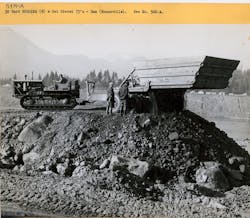Iron Works: The LeTourneau Buggy
Robert G. LeTourneau was the leading advocate of high-speed, high-capacity, mobile earthmoving machinery, and his numerous inventions spearheaded the concept. His interest in such equipment stemmed from his own experience as an earthmoving contractor; machines that were available to him in the early 1920s simply did not suffice for the tasks at hand, so he designed and fabricated his own.
One of his innovations was the large, wheeled dump wagon. Small dump wagons had been used for decades behind horses and mules, and most were bottom dumps. Larger wheeled bottom-dump wagons for use behind steam traction engines followed, then crawler-mounted dump wagons for use behind crawler tractors.
The Historical Construction Equipment Association (HCEA) is dedicated to preserving the history of the construction, dredging and surface mining equipment industries. It operates National Construction Equipment Museum and archives in Bowling Green, Ohio, and publishes the quarterly magazine, Equipment Echoes, from which this text is adapted. Contact: 419.352.5616 or [email protected].
LeTourneau developed and used his first dump wagon design, the Hopper Wagon, in 1928. Traveling on oversized steel wheels and carrying 16 cubic yards, it was—like so many other LeTourneau designs—a departure from any comparable machine. The body sloped down to the rear, so that it dumped by gravity merely by raising the tailgate with a rope pull. The tailgate could set to a preset position for controlled dumping, and closed itself when the wagon was empty. A crawler-mounted version for use on softer ground soon followed.
The next year, LeTourneau was awarded the contract to grade the Benicia approach to Southern Pacific’s Carquinez Bridge in California, and he designed and built his next wagon, the 12-yard Chariot, on this job site. The Chariot rode on the same wheels as the Hopper Wagon. It was the precursor of the rock wagon attachment for rubber-tired prime movers; unlike the Hopper Wagon, it dumped by tipping the body back as the rear of the wagon was drawn forward by a cable from the towing tractor.
The first rubber-tired dump wagons were built circa 1933. These were 25-yard behemoths called Slide-Out Buggies. They travelled on 16 11.25x20 Firestone tires that gave the wagon good flotation in poor conditions. Rather than a true end-dump design, the Buggy was the first known positive ejection wagon; operated like the Chariot from a cable control unit on the towing tractor, it dumped by drawing its bottomless body backwards from the Buggy’s solid frame, so the load simply fell out (shown). The design proved to be sturdy, economical and simple to maintain.
Several derivatives of the Buggy were produced. Not only were there different capacities and configurations, such as a trailer behind a truck tractor or a dump body on a truck, but the Buggy’s chassis was offered as a transport trailer for everything from construction equipment to custom heavy hauling.
LeTourneau went on to revolutionize earthmoving with his single-axle Tournapull prime mover, and he developed various end-, bottom- and positive ejection-dump wagons for use with it. The configuration of a rubber-tired off-highway prime mover and end dump trailer is now considered to be the predecessor of today’s articulated dump truck.
